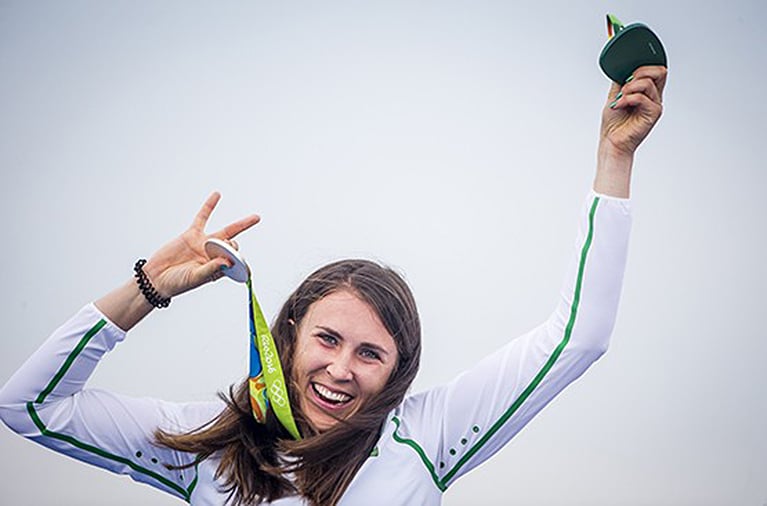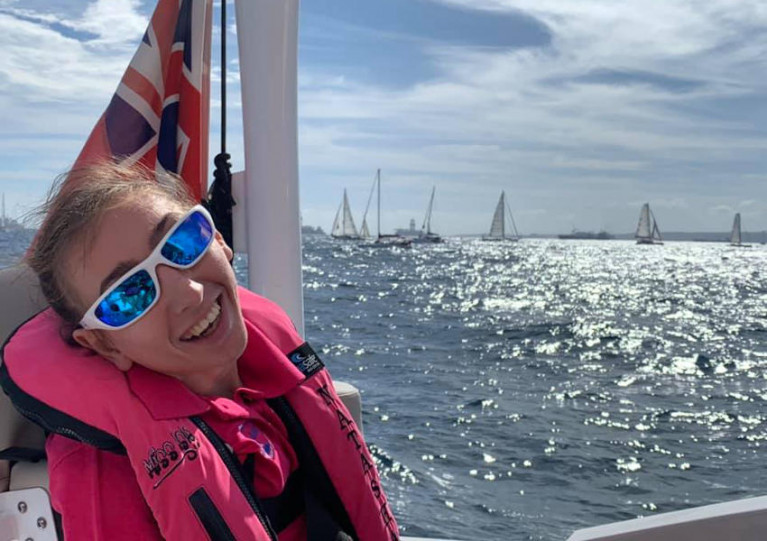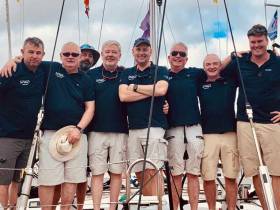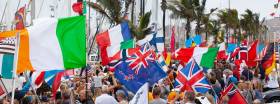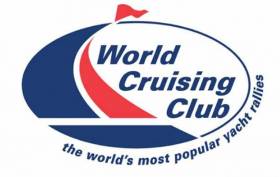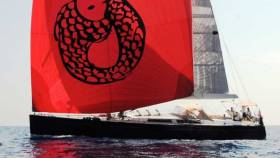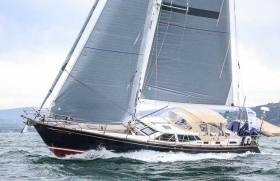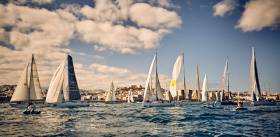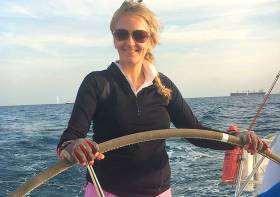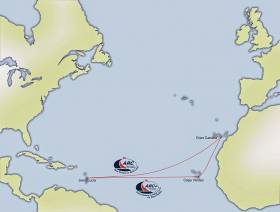Displaying items by tag: ARC
Pioneering Sip & Puff Sailor Crosses Atlantic in World First
A young woman with cerebral palsy has become the first person to cross the Atlantic by ‘sip and puff’ sailing.
Natasha Lambert — who three years ago sailed into Dun Laoghaire to complete a crossing of the Irish Sea by the same means — controls the helm and sails of her vessel with a straw.
As Yachting Monthly reports, Natasha’s father Gary designed the system that drives her Nautitech Open 46, named Blown Away — which also happens to be the largest vessel ever adapted for sip and puff sailing.
Twenty-three-year-old Natasha lives with quadriplegic athetoid cerebral palsy but hasn’t let it stop her attempting sailing feats that would be a challenge for even the most experienced able-bodies sailors.
And her latest achievement was skippering Blown Away with her family from Gran Canaria to the Caribbean as part of the 2020 ARC rally.
Yachting Monthly has more on the story HERE.
National Yacht Club Crew Fourth in Atlantic Rally for Cruisers
A National Yacht Club crew from Dublin Bay have finished fourth in class and fourth monohull in the 2019 Atlantic Rally for Cruisers (ARC).
As previously reported on Afloat, the NYC crew made the crossing in the 80-foot Swan yacht Umiko.
The transatlantic crew were former NYC Commodore Paul Barrington, Paul Fagan, Teddy Murphy, Dave O’Reilly, Barry O’Sullivan Alan Daly and Brian Uniacke. The NYC sailors were also joined by a father and daughter from Sweden Carl and Carolina Urban. The skipper was Olly Cotterdel.
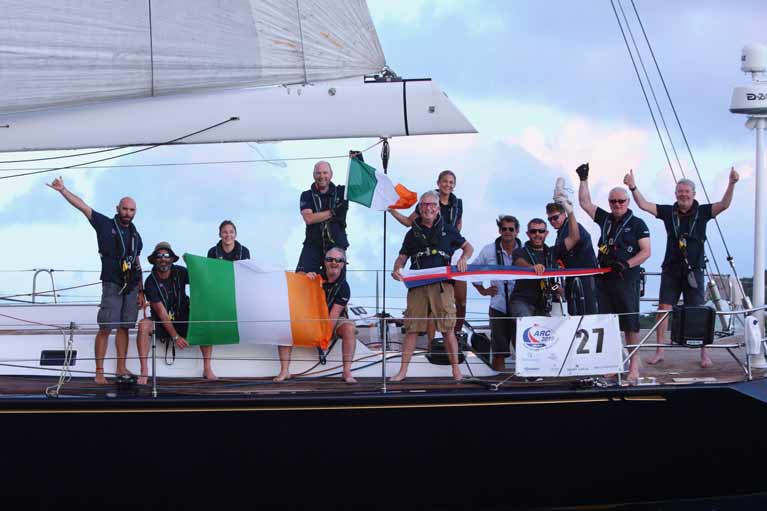 The NYC crew cross the finish line in St Lucia Photo: Photo Action
The NYC crew cross the finish line in St Lucia Photo: Photo Action
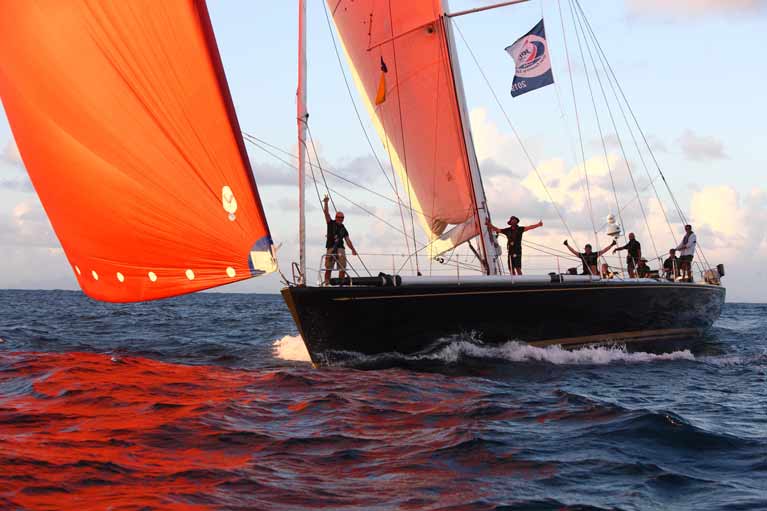
It is the second transatlantic success in as many days for the NYC as cadet member Conor Totterdell finished second in the RORC Transat race.
Opening Ceremony Marks One Week to the Start of ARC 2019
With the majority of boats now docked in Las Palmas de Gran Canaria and crews busy making preparations for their 2,700 nm Atlantic ahead of start of the ARC next Sunday - 24th November - it was time to mark the official opening of the 34th edition of the world's largest transocean rally for cruisers.
The Irish flag was flying proudly in the opening ceremony as an Irish group of sailors have chartered the British flagged yacht Umiko, a Swan 80, to take part in ARC 2019.
It's always a favourite with ARC participants as they proudly follow behind a lively carnival-like procession around the marina, representing their countries with national flags.
"Irish sailors have chartered the British flagged yacht Umiko, a Swan 80"
This year was particularly special as the High Commissioner for Saint Lucia in London, H.E. Guy Mayers, along with a large group of Saint Lucians wearing colourful national dress, joined principal flag bearers for Spain, Gran Canaria and the Canary Islands to lead hundreds of ARC crews around Las Palmas Marina. 2019 marks the 30th anniversary of the event's arrival in the beautiful tropical Caribbean island of Saint Lucia and the 40th anniversary of the country's independence, with the occasion being marked in a number of ways for this year's rally. As a special year, the High Commissioner brought together a group of Saint Lucians from London to witness what makes the ARC such a defining experience for cruising sailors and share the excitement that they will spend three weeks at sea to reach Saint Lucia's shores.
With a spectacular, colourful carnival parade around the whole marina, crews from 35 different nations waved their national flags patriotically and got into the spirit of the event. For many this will be their longest ocean passage and for others, it is a regular trip across the pond, but for all, it has been the culmination of a lot of hard work and preparation in the build-up to this great adventure.
The international conga line was led by the Banda Gran Canaria, with the Batucada Timbalao beating a salsa rhythm at the back of the line. Once the procession had completed its parade around the marina, sailors were welcomed to the ARC by World Cruising Club's Managing Director Andrew Bishop. He thanked The Tourist Board of Gran Canaria and the Ayuntamiento de Las Palmas de Gran Canaria for their support, and praised the Port Authority who manage the marina for accommodating the vast number of ARC boats year on year.
Carlos Alamo, Consejero de Turismo del Cabildo de Gran Canaria spoke on behalf of the Tourist Board of Gran Canaria: "I welcome you. It is a pleasure for us to be chosen by you to set off from here to the Caribbean island of Saint Lucia in this 34th edition of the Atlantic Rally for Cruisers. I hope that you are enjoying your stay in Gran Canaria, and have a safe crossing."
Coming to see the crew's preparations for the second time, and personally wish them well on the voyage, Guy Mayers High Commissioner for Saint Lucia in London addressed ARC sailors and said, "When you come to Saint Lucia you will understand what unique hospitality is all about. I want to thank all of you who have chosen to be part of this. We welcome you with open arms and will continue to grow the ARC together so thank you for choosing Saint Lucia and we wish you well across the ocean."
A week today, from 12:30 on Sunday 24 November, the fleet will begin their ocean adventure and say farewell to Gran Canaria, but before then, there is a packed programme of events for the days ahead.
The ARC fleet will set off this year with 190 entries from 35 different countries and is truly a multinational celebration which showcases the international flavour of the rally. The attraction to sail in company as one fleet has continued to have undaunted appeal. Twenty two boats will be sailing across with children and 44 will be part of a family adventure this year, with the youngest crew member being 3 years old on the German boat Gentoo.
The ARC is very diverse and attracts boats of all sizes and design. This year is no exception; the smallest being the German-flagged Amel Fango Falema at 10m, and then there's the superyacht 32m Ulisse, at the larger end of the size range - and everything in between! There has been a significant swing towards multihulls once again year and 40 catamarans will be on the start line in a week's time. The average cruising boat can expect to arrive in their final destination at Rodney Bay, Saint Lucia in 18 to 21 days, but the competitive Racing Division which will see 28 boats vying for position, will hope to reach the rum punch much sooner.
One special crew to follow this year is the ARC Youth Team, bringing 12 together sailors aged 18-30 from Gran Canaria, Saint Lucia and the UK to sail on board a 72ft Challenge sailing yacht, Challenger 1, operated by Tall Ships Sail Training Adventures. They will be accompanied on board by a professional Skipper and Mate, and two qualified Watch Leaders, on what will be an 'once-in-a-lifetime opportunity' and are supported by sponsors and benefactors who have been in involved with the ARC over the past three decades. The crew marched in the parade today under their own ARC Youth Team flag and will officially step on board the yacht for the first time tomorrow for some training.
As start day draws nearer, preparations for the crossing increase urgency as provisions are stowed, equipment is checked and re-checked, and further crew members fly in daily to join the yachts. World Cruising Club, together with local supporters including the Tourist Board of Gran Canaria and the Ayuntamiento de Las Palmas de Gran Canaria, the Port Authority and local chandlery Rolnautic, organise an extensive programme for the participants. In week two of the programme, many will take advantage of the free seminars led by some of the most respected cruising sailors and marine specialists in the industry. The famous ARC social programme is a fun way for participants to get to know one another, and form an Atlantic crossing community before they head out to sea.
Two Irish Boats Prepare for 2020 ARC Rally
The Atlantic Rally for Cruisers (ARC) will bring together a diverse group of boats and crews to sail with the historic ocean rally celebrating its 34th edition in 2019 and while there are no Irish entries among the fleet for next Sunday's start, two Irish boats are listed for next year's edition as part of the World ARC rally.
Conor Haughey will sail across in his Moody 54 Hibernian and Brendan Cahill is crossing in his 14m Lagoon 450, Boru. The 2020/2021 entry list is here
As the rally preparations commence, start dates for the two routes are scheduled for Sunday 10th November for ARC+ and Sunday 24th November for the ARC. As the largest transocean rally, the ARC is also the most eclectic; Sailors on all sizes of budget, of all ages and on all types of boat join in to cross the Atlantic on the trade-winds together, benefiting from the safe and social framework that the rally provides
The first stage of the rally sails from Las Palmas de Gran Canaria to Mindelo Marina, São Vicente, a distance of approximately 850nm taking between 5 and 7 days for a 12m (40’) cruising boat. Following the 3 to 5 day stopover, yachts can choose to sail to either Rodney Bay, Saint Lucia or Blue Lagoon, St. Vincent. The passage to the Caribbean is approximately 2150nm, and will take 12 to 16 days.
Crossing the Atlantic from the Canaries via Cape Verde enables boats make the most of the northeast trade winds; their latitude at 16º50’N is right in the path of the trade winds, promising a great sail to the Caribbean and a warm welcome on arrival.
More here
Nereida Takes on Irish Hopes in ARC 2017 as Pamela Returns
Eamon Crosbie's Discovery 55 Pamela from Dun Laoghaire has headed back to start-point Gran Canaria in the Atlantic Rally for Cruisers 2017 writes W M Nixon. According to the current tracker situation, Pamela is heading eastward after a week of racing, but the mantle of Irish hopes has been taken up by Karl Fleming’s Hanse 630 Nereida, IRL 1556.
Karl Fleming is an international developer best known in Ireland for his extensive Pirate’s Cove Adventure Centre in Courtown, Co Wexford, but he also has other international projects. Nereida is a substantial and swift modern performance cruiser in classic contemporary Hanse style which can give a good account of herself in proper sailing conditions. But the wind situation along the ARC 2017 course is currently so frustrating that she is currently shown at just 5.5 knots, lying seventh in Cruising A and 24th overall in the 245-boat fleet.
Race tracker here
Eamon Crosbie's Discovery 55, 'Pamela' Sets Sail on the ARC Rally
The only Irish registered yacht in this year's Atlantic Rally for Cruisers (ARC) is Eamon Crosbie's Discovery 55, Pamela.
As Afloat.ie reported earlier Crosbie set off from Dun Laoghaire on the adventure with Dublin Bay Sailing Club's Brian Mathews on board. Mathews will be absent from Dublin Bay racing for about a year, having joined Crosbie, a former Round Ireland Race winner, in what is the start of a world cruise.
An international fleet of yachts taking part in the 32nd edition of the Atlantic Rally for Cruisers (ARC) set sail on Sunday from Las Palmas de Gran Canaria, beginning an amazing transatlantic journey to the Caribbean island of Saint Lucia.
It is a particularly diverse fleet this year with boats from 30ft to 95ft setting off on the same transatlantic course, including 156 monohulls, 28 catamarans and 2 trimarans. The sailors themselves are just as varied, aged from 3 years old to over 80.
While the ARC is a cruising rally, there is a start and finish line, and the boats are split into divisions according to size, type and competition. The first start today was for the multihull division, led over the line by American flagged Lagoon 42-4 Libelula, followed by Seawind 1160 X86 and the fleet's largest trimaran, Rapido, living up to her name coming over the line third before storming off down the Gran Canarian coast.
Following on, 27 boats in the ARC Racing Division were equally eager to stretch their sea legs and sail out into the Atlantic. Regular ARC Skipper and Class winner Ross Applebey brought through Scarlet Island Girl hot on her heels swiftly followed by Valerio Bardi's Swan 46 Mk II Milanto.
The first boats to cross the line in the Cruising Division were Norwegian Arcona 400 Tiffin, Swedish Najad 460 Ellen and British Grand Soleil 56 Mad Monkey.
Of the 186 boats sailing on the ARC direct route, 4 are still in Las Palmas with technical problems delaying their departure.
The majority of boats will take 18-21 days to make the 2700 nautical mile Atlantic crossing, arriving in Rodney Bay Marina, Saint Lucia.
Tracker here
What Are The Most Common Breakages For Ocean-Going Yachts?
#ARC - Ripped sails and breakages caused by chafe were the most common repairs required by transatlantic cruisers in last year’s ARC rally.
That’s according to a survey by Yachting World to detail the kinds of breakages experienced at sea — and what solutions skippers recommend to deal with them.
The magazine polled all 290 yachts that took part in the rally from the Canary Islands to the Caribbean last November and December, which also featured a number of Irish skippers and crew.
And the findings were a mix of the expected and the surprising.
More than half the fleet — 167 out of 290 yachts — experienced some kind of breakage or malfunction in last year’s rally.
Predictably enough, some of these are par for the course when it comes to long-distance ocean crossings, from issues with steering and rigging to blocked toilets.
But the magazine also found that “worrying number of yachts” had problems with their kicking straps and gooseneck fittings — issues it sees “time after time”.
Overpowered yachts, sometimes sailing with old sails, led to sail damage in several cases, while lack of routine maintenance was noted as the common thread between a number of generator problems.
Yachting World has much more on the story HERE.
Irish ARC Sailors Cross The Atlantic in Time for Christmas in St. Lucia
At least three Irish flagged boats as well as a number of international boats with Irish crew onboard have finished or are nearing the Caribbean finish of the Atlantic Rally for Cruisers having crossed from Gran Canaria up to a fortnight ago.
Nicholas Musgrave's Jeanneau Sun Odyssey 50DS Jasmine and Diamuid Good's X–yacht Exhale, both from Cork, are close on the St. Lucia finish line while the home–built yacht Rogue Trader from Newry in County Down is also due to finish this weekend. Rogue Trader's exploits were previously reported on Afloat.ie here.
Storme Delaney from Sandycove in County Dublin and a member of the Royal Irish Yacht Club in Dun Laoghaire is one of a number of Irish sailors among an international line–up of crews across the 215–boat ARC fleet.
Delaney, who is a regular competitor at Cork Week and Calves Week completed the 2700–mile trip on board Andrew Middleton's Beneteau First 47.7, EHO1. Delaney previously sailed in Antigua Race Week 2009 and 2010 and sailed in the 2014 Round Ireland Race from Wicklow on board the Sigma 38 State O'Chassis.
More on the ARC here.
Newry Couple Set Out Across Atlantic To Achieve Ambitious Dream
Ireland is well represented by an ambitious young cruising couple in a full house for this year's Atlantic Rally for Cruisers - Both route options are at capacity with waiting lists in place for the first time since the creation of ARC+ in 2013, allowing for a total of 300 boats to sail under the ARC banner this November. It's set to be the biggest migration ever to sail with the rally to the Caribbean shores of Saint Lucia!
Claire McCluskey & Nick Russell are a young couple from Ireland, who admit they “may have gotten a bit carried away”. Not long after they met in 2012, a conversation in the pub grew legs and evolved into a challenge: to sail across the Atlantic Ocean. This was a high provocation, considering at that time, one of them had never even been on a boat before. “But now, four years, 56 feet of boat and countless litres of blood, sweat and tears later, we are almost ready to go!”
Their boat Rogue Trader is a homebuilt, wooden‐hulled ketch. It took twenty years and three different owners to complete the build, until she was finally launched in Newry, Northern Ireland in 2008.
Claire and Nick became her custodians in 2013 and although structurally she was built beautifully, she needed a lot of cosmetic work, and they have worked tirelessly for the past three years cleaning, painting and refitting her ready for the ARC. “We hope to finally achieve what this boat was built for open water sailing and adventure.”
“We have each harboured a long enduring desire to take on a grand adventure, and we both feel incredibly grateful to find ourselves in the fortunate position to finally pursue such a dream. I often can’t quite believe that we have made it to this point and we have barely even started yet! We are tremendously excited at the prospect of getting to experience the sea and distant places in ways we have never known before while all the time building upon our confidence in our new lifestyle.”
31st Atlantic Rally for Cruisers prepares to set sail
ARC sailors have a choice of routes with the introduction of ARC+ Cape Verde, and two starts are planned for 2016: ARC+ will depart Las Palmas de Gran Canaria on Sunday 6 November, with approximately 75 boats sailing to Mindelo, Sao Vincente, Cape Verde for a 3 to 5 day stopover before the restart to Saint Lucia on 16 November.
The larger ARC fleet of over 200 boats will start their own Atlantic adventure on Sunday 20 November sailing directly to Saint Lucia.
30th ARC Rally – Mid-Way to St Lucia
With most of the cruising fleet around the half-way mark, Frank Quinn updates his earlier report on the 30th ARC Rally for cruisers that includes three Irish boats
It was a windy and lumpy start as the fleet in the 30th ARC left Las Palmas on 22 November. 25 knots, gusting 30, would be weather most coastal sailors would regard as their signal to stay in port. In the case of ocean crossings, it's business as usual -- although our skipper did comment that the start was delayed in the past under similar conditions.
Las Palmas harbour was alive with well-wishers and jostling boats for an hour before the off: the racing fleet going first, followed by the cruising division. Aboard Nina, Stephen Cooke's Nordship 43 DS, the sense of anticipation was huge as we reefed down for our first night. A quartering 10 ft swell, coupled with following 25 knot wind, kept the watches busy. With six on board, we have opted for the classic delivery crew pattern of 4 hours on/4 hours off.
Briefings in Las Palmas recommended rounding the island then making straight for St Lucia. Our skipper preferred to head south first, a decision which proved worthwhile. Although we had three days of roller-coaster sailing, we gradually picked up more even seas before we turned to the west. Here at the half way point after 13 days, we expect to make up time now that we are on the rhumb line directly to Rodney Bay.
Sailplan is a poled-out genoa with reefed main, delivering a reliable 7-8 knots. With the exception of one calm day, we have had nothing but steady 17-25 knots on our starboard quarter. On the day the wind died, we flew our cruising chute for a pleasant six hours in the sunshine. On board, life has settled into a routine around sailing, sleeping and eating. Boat systems are working well, particularly the Raymarine autohelm which is flawless -- although it relies on the generator to keep batteries alive. The only thorny issue so far has been a leaky bolt on the Hydrovane self-steering. With following seas, its transom mounting has been under pressure. Yesterday we hove-to, removed the bolts and resealed them: stern cabin floor is dry again.
We learn from the ARC reports that several boats who took the northern route suffered gear damage and diverted to the Cape Verde Islands for repair. One boat had a medical emergency and managed to hook up with a passing freighter for help.
At 1940 on Thursday (3 December) the skipper of Magritte to advised the yacht was taking on water. The source of the ingress could not be identified or stemmed and the four crew on board indicated that assistance was required as the situation worsened. On the advice of MRCC Falmouth, a MAYDAY was issued and the yacht’s EPIRB activated. The liferaft was readied in anticipation of a possible need to abandon the yacht.
MRCC Cape Verde coordinated the evacuation of the crew. Cargo vessel SCL Basilea diverted to provide assistance, reaching Magritte at approximately 0500 (UTC). The crew were safely evacuated and are all well on board SCL Basileawhich is now en route to Spain. Magritte was abandoned at approximate position 16 44.36N 027 27.82W.
What of the three Irish boats in the ARC?
Alpaire, a Hallberg-Rassy 48 skippered by Des Cummins in 634 miles to go; Crackerjack, Colum O'Sullivan's Oyster 53 has 848 miles; and BAM, Conor Fogerty's HYC-based Sun Fast 3600, among one of the smallest boats in the racing fleet, has just 600 miles to the finish line.
Reporting in from Crackerjack on December 2nd, Tralee SC's Brian O'Sullivan told Afloat.ie: 'We passed mid way point & running downwind at 7 to 8 kts all day. No sightings other than whales and flying fish for 5 days! Great on board, eta Dec 12th'
The ARC camaraderie pops up every now and again on the VHF, when AIS signals appear on nav station plotters. Not just the ARC boats: a shout came in last night from Nomad IV, a 98' yacht racing a TransAt with a crew of 17. They passed at 18 knots six miles to N, happy to chat and warning of upcoming squalls.
With our target of 150 - 180 miles a day, Nina is looking good for an overall crossing time of 21 days. The trade winds are steady, she is a fine seagoing boat and we have plenty of chocolate HobNobs on board. In the ongoing swell, this definition of the perfect seagoing cook, courtesy of author Theo Dorgan, is particularly apt:
"A fireproof, acrobatic contortionist, with a strong stomach, an ability to work fast and a distinct masochistic streak".


























